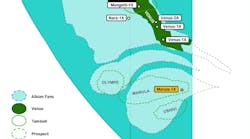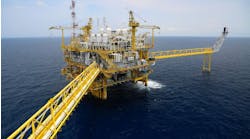Look for more growth over the next five years in deepwater drilling and development and in the technology that supports it. That is the consensus of a number of reports in this month's issue.
The longer-term trend is for more deepwater developments and a continued increase in the use of subsea development solutions, according to Will Rowley of Infield Systems Ltd. As he sees it, an analysis of the deepwater drilling arena reveals the changing nature of the deepwater subsea sector. Of the $57 billion to be spent in 2004-2008 on deepwater projects around the world, Rowley expects $13.7 billion for over 1,348 development wells. This is in addition to $20.5 billion forecast for just over 750 deepwater exploration and appraisal wells.
As Rowley puts it (Deepwater drilling analysis suggests significant increase in activity, page 40), "Development wells are one of the backbones of the deepwater drilling industry. Multi-well and often multi-field contracts spread over many years help to regulate the income flow and allow for a reasonable period of constancy, with utilization rates that rarely fall below 90% and often reach over 98% for suitable rigs. This high level of utilization of fifth-generation rigs and drillships also creates the stability required to commit to expensive technology that helps to push the envelope even deeper."
Meanwhile, the month's Latin America report focuses on Petrobras' efforts to develop new concepts to make production feasible from new deepwater discoveries.
"The program is also geared to reduce costs in production developments and to reduce lifting costs in currently producing fields at water depths beyond 1,000 m," says Dr. Jacques Braile Saliés, Petrobras' coordinator of the company's ultra-deepwater R&D program, called Procap-3000. His discussion of Petrobras' newest R&D efforts begins on page 24.
Which leads us to the subject of floating production, where growth and change are in the wind.
"Although FPSO numbers continue to grow, future identified prospects show that other vessel types, particularly TLPs and spars, may be increasingly common among new installations." That's the conclusion of Steve Robertson and Georgie MacFarlan of Douglas-Westwood Ltd. (FPSOs lead strong growth in floating production sector, page 100). The two analysts forecast 124 floating production system prospects planned and possible for the 2004-2008 period, with Africa and Asia combined representing more than 50% of the prospective installations and North America and Latin America together accounting for another 32%. Western Europe, on the other hand, is expected to experience a strong decline in activity. Only eight FPS installations are in prospect there for the 2004-2008 period, as opposed to the 13 installations recorded in the 1999-2003 period. Total worldwide FPS capex forecast for the period is $31 billion.
Finally, Exploration Editor Victor Schmidt takes a fresh look at the sine qua non of the oil and gas industry – finding the hydrocarbons. If that doesn't happen, all other forecasts are a moot point.
The process of identifying drilling prospects could benefit from new thought, Schmidt says, and that could include a greater emphasis on human ingenuity, a move away from the paradigm of the last 15 years.
"Improved computers, better interpretation software, and better imaging capability created a form of prospect manufacturing based on advancing computer technology," Schmidt says. "Along with the general brainpower decline caused by restructuring and mergers, there has been a decline in the use of cost-effective exploration techniques, especially micropaleontology and potential field geophysics."
Or, as he puts it more succinctly, "Machine power replaced brainpower." He offers some thought of how to maximize the benefits of both, but to do that, an appreciation of brainpower has to emerge.
Don't miss his column on page 22.
Eldon Ball


